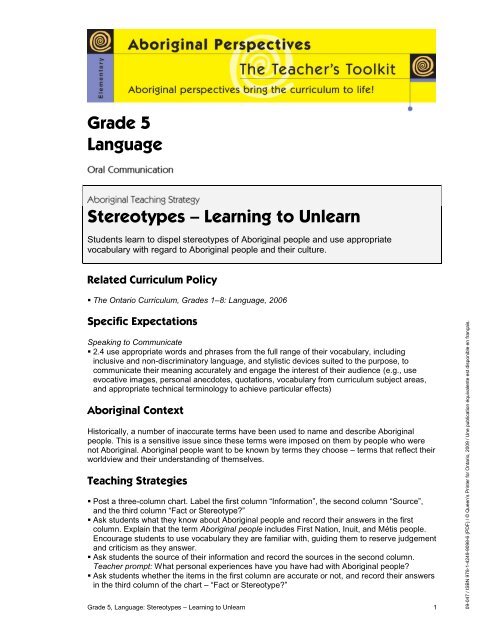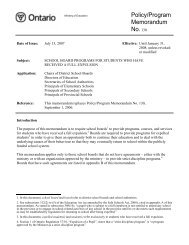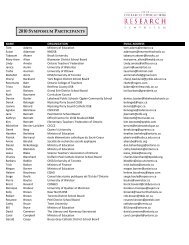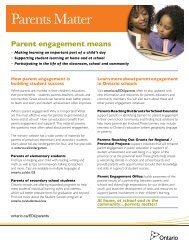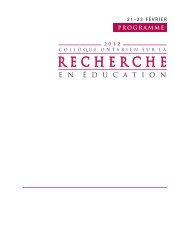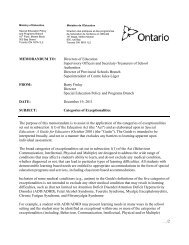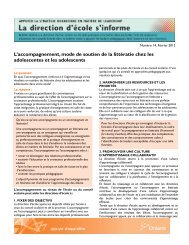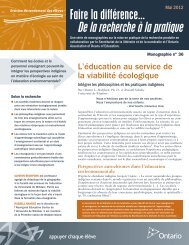Grade 5 Language – Stereotypes: Learning to Unlearn
Grade 5 Language – Stereotypes: Learning to Unlearn
Grade 5 Language – Stereotypes: Learning to Unlearn
Create successful ePaper yourself
Turn your PDF publications into a flip-book with our unique Google optimized e-Paper software.
09-047 / ISBN 978-1-4249-9098-6 (PDF) / © Queen’s Printer for Ontario, 2009 / Une publication équivalente est disponible en français.<br />
<strong>Grade</strong> 5<br />
<strong>Language</strong><br />
<strong>Stereotypes</strong> <strong>–</strong> <strong>Learning</strong> <strong>to</strong> <strong>Unlearn</strong><br />
Students learn <strong>to</strong> dispel stereotypes of Aboriginal people and use appropriate<br />
vocabulary with regard <strong>to</strong> Aboriginal people and their culture.<br />
Related Curriculum Policy<br />
• The Ontario Curriculum, <strong>Grade</strong>s 1<strong>–</strong>8: <strong>Language</strong>, 2006<br />
Specific Expectations<br />
Speaking <strong>to</strong> Communicate<br />
• 2.4 use appropriate words and phrases from the full range of their vocabulary, including<br />
inclusive and non-discrimina<strong>to</strong>ry language, and stylistic devices suited <strong>to</strong> the purpose, <strong>to</strong><br />
communicate their meaning accurately and engage the interest of their audience (e.g., use<br />
evocative images, personal anecdotes, quotations, vocabulary from curriculum subject areas,<br />
and appropriate technical terminology <strong>to</strong> achieve particular effects)<br />
Aboriginal Context<br />
His<strong>to</strong>rically, a number of inaccurate terms have been used <strong>to</strong> name and describe Aboriginal<br />
people. This is a sensitive issue since these terms were imposed on them by people who were<br />
not Aboriginal. Aboriginal people want <strong>to</strong> be known by terms they choose <strong>–</strong> terms that reflect their<br />
worldview and their understanding of themselves.<br />
Teaching Strategies<br />
• Post a three-column chart. Label the first column “Information”, the second column “Source”,<br />
and the third column “Fact or Stereotype?”<br />
• Ask students what they know about Aboriginal people and record their answers in the first<br />
column. Explain that the term Aboriginal people includes First Nation, Inuit, and Métis people.<br />
Encourage students <strong>to</strong> use vocabulary they are familiar with, guiding them <strong>to</strong> reserve judgement<br />
and criticism as they answer.<br />
• Ask students the source of their information and record the sources in the second column.<br />
Teacher prompt: What personal experiences have you have had with Aboriginal people?<br />
• Ask students whether the items in the first column are accurate or not, and record their answers<br />
in the third column of the chart <strong>–</strong> “Fact or Stereotype?”<br />
<strong>Grade</strong> 5, <strong>Language</strong>: <strong>Stereotypes</strong> <strong>–</strong> <strong>Learning</strong> <strong>to</strong> <strong>Unlearn</strong> 1
Teacher prompts: What is a stereotype? Where do stereotypes come from? Are you aware of<br />
any deroga<strong>to</strong>ry terms used by people <strong>to</strong> describe Aboriginal people? Do you know of any beliefs<br />
people have about Aboriginal people that are inaccurate? Where do these terms and inaccurate<br />
beliefs come from? How are they spread? Why do people use the terms and believe the<br />
inaccuracies? How do the terms make you feel? How do you think they make Aboriginal people<br />
feel? Why is it important <strong>to</strong> identify these terms and correct the inaccurate information?<br />
• Have students watch a video or read a book or newspaper articles about Aboriginal people.<br />
• Discuss the video, book, or articles with them.<br />
Teacher prompts: How were the Aboriginal people portrayed? Were the depictions accurate?<br />
What was accurate about them? What was inaccurate? Were there any stereotypes in the<br />
depictions? What facts do you know that contradict these stereotypes?<br />
• Extend the discussion of stereotyping by exploring inaccurate beliefs about or racist terms for<br />
people of other cultures.<br />
Teacher prompt: As individuals, what can we do <strong>to</strong> s<strong>to</strong>p the use of stereotypes?<br />
Resources<br />
For Angela. First Nations: The Circle Unbroken video series. A s<strong>to</strong>ry of racism and<br />
empowerment, inspired by the experience of Rhonda Gordon and her daughter, Angela.<br />
Available from the National Film Board website, at http://www.nfb.ca/collection/films/fiche/<br />
?id=30183.<br />
Indian and Northern Affairs Canada. “Terminology”. http://www.ainc-inac.gc.ca/ap/tln-eng.asp.<br />
Glossary of terminology used by Indian and Northern Affairs Canada.<br />
Indian and Northern Affairs Canada. Words First: An Evolving Terminology Relating <strong>to</strong> Aboriginal<br />
Peoples in Canada. http://www.ainc-inac.gc.ca/ap/pubs/wf/wf-eng.asp.<br />
Keeshig-Tobias, Lenore. Bird Talk. Orlando, FL: Harcourt Brace, 1994. When Polly’s classmates<br />
say she’s not Indian because she doesn’t have feathers or red skin, her mother reminds her of<br />
her heritage and her large extended family.<br />
Positively Native. Many Voices video series. http://www.visualed.com. This video tells the s<strong>to</strong>ry of<br />
Martin, who makes a video about his native way of life, hoping <strong>to</strong> dispel some of the stereotypes<br />
he faces daily.<br />
SWAP-TV. www.swap-tv.com. A television series that lets young people spend two days in each<br />
other's lives. The programs air on TVOntario, Access, Knowledge Network, and SCN.<br />
Making Community Connections<br />
• Invite your board’s anti-racism officer <strong>to</strong> speak <strong>to</strong> the class about the importance of using<br />
appropriate terminology for all cultural groups.<br />
• Contact a local Métis organization, Friendship Centre, or First Nation community <strong>to</strong> invite a<br />
speaker <strong>to</strong> talk <strong>to</strong> the class about correct terminology with regard <strong>to</strong> Aboriginal people and their<br />
culture and about why these terms are preferred by Aboriginal people.<br />
ABOUT THE TEACHER’S TOOLKIT<br />
This teaching strategy is one component of Aboriginal Perspectives: The Teacher’s Toolkit, a<br />
collection of resources designed <strong>to</strong> help Ontario educa<strong>to</strong>rs bring Aboriginal perspectives in<strong>to</strong> the<br />
classroom. Based on the revised Ontario curriculum, the collection includes resources for<br />
educa<strong>to</strong>rs at both the elementary and secondary levels. Other resources in this series can be<br />
found on the ministry website, at www.edu.gov.on.ca.<br />
<strong>Grade</strong> 5, <strong>Language</strong>: <strong>Stereotypes</strong> <strong>–</strong> <strong>Learning</strong> <strong>to</strong> <strong>Unlearn</strong> 2
<strong>Grade</strong> 5, <strong>Language</strong>: <strong>Stereotypes</strong> <strong>–</strong> <strong>Learning</strong> <strong>to</strong> <strong>Unlearn</strong> 3


